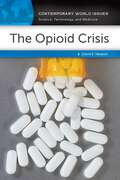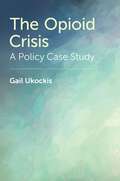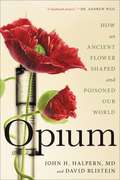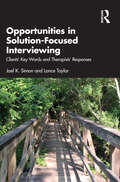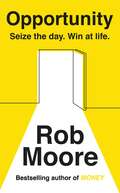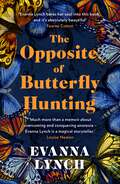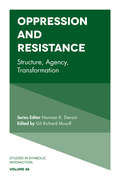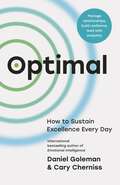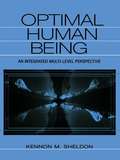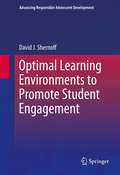- Table View
- List View
Opiatabhängigkeit: Interdisziplinäre Aspekte für die Praxis
by Eckhard Beubler Hans Haltmayer Alfred SpringerDas Wissen über "Opioidabhängigkeit" ist beträchtlich gewachsen. Neben Grundlagenforschung, Pharmakotherapie, somatischer/psychiatrischer Komorbidität, gewann der interdisziplinäre Aspekt zunehmend an Bedeutung. Die Autoren des Fachbuches geben erstmals einen aktuellen Überblick über die pharmakologischen, medizinischen, psychotherapeutischen und rechtlichen Grundlagen. Sie erweiterten die 2. Auflage um neue Beiträge zur Chirurgie, Dermatologie, Gynäkologie und Schmerztherapie. Plus: Ergänzungen u.a. zu Begutachtungspraxis hinsichtlich Suchtgefährdung und –krankheit und Fahrtauglichkeit. Die Autoren berichten aus ihrer langjährigen Praxis.
Opiate Receptors, Neurotransmitters, and Drug Dependence: Basic Science-Clinical Correlates
by Barry StimmelExperts address the role of neuromodulators and opiate receptors in alcohol and drug dependence. They present innovative research techniques, new discoveries, and possible clinical correlates that allow for a much greater understanding of the clinical phenomena surrounding alcohol and narcotic use. Included in this thought-provoking volume are a comprehensive review of the current knowledge of the endogenous opiates, their interactions with the opiate receptors, and the potential relationship that these substances might have in promoting the development of dependence, tolerance, and withdrawal; the translation of the basic physiologic findings occuring during withdrawal to treatment of withdrawal symptoms in the clinical setting; and a physiological explanation for the rationale of using clonidine and naltrexone to accelaerate the detoxification process without undue discomfort.
Opiate Receptors, Neurotransmitters, and Drug Dependence: Basic Science-Clinical Correlates
by Barry StimmelExperts address the role of neuromodulators and opiate receptors in alcohol and drug dependence. They present innovative research techniques, new discoveries, and possible clinical correlates that allow for a much greater understanding of the clinical phenomena surrounding alcohol and narcotic use. Included in this thought-provoking volume are a comprehensive review of the current knowledge of the endogenous opiates, their interactions with the opiate receptors, and the potential relationship that these substances might have in promoting the development of dependence, tolerance, and withdrawal; the translation of the basic physiologic findings occuring during withdrawal to treatment of withdrawal symptoms in the clinical setting; and a physiological explanation for the rationale of using clonidine and naltrexone to accelaerate the detoxification process without undue discomfort.
The Opioid Crisis: A Reference Handbook (Contemporary World Issues)
by David E. NewtonA comprehensive overview of opioid use throughout human history, current problems surrounding opioid abuse, and suggested approaches to solving these problems.Dependence on opioids has grown into an epidemic, its effects felt globally and most of all in the United States. The Opioid Crisis: A Reference Handbook provides a detailed and accurate history of opioid use, helping readers to understand how the crisis developed, as well as a review of problems arising out of this crisis and some of the solutions that have been proposed.The volume additionally comprises ten essays from individuals who have a personal or educational connection to the crisis and short biographical and explanatory essays on important individuals and organizations working to mitigate the opioid crisis by supporting research of the biological systems implicated in opioid dependence and raising awareness of the challenges of addiction in America today. It also provides resources for readers who want to continue their study of the topic or pursue research in the field.
The Opioid Crisis: A Reference Handbook (Contemporary World Issues)
by David E. NewtonA comprehensive overview of opioid use throughout human history, current problems surrounding opioid abuse, and suggested approaches to solving these problems.Dependence on opioids has grown into an epidemic, its effects felt globally and most of all in the United States. The Opioid Crisis: A Reference Handbook provides a detailed and accurate history of opioid use, helping readers to understand how the crisis developed, as well as a review of problems arising out of this crisis and some of the solutions that have been proposed.The volume additionally comprises ten essays from individuals who have a personal or educational connection to the crisis and short biographical and explanatory essays on important individuals and organizations working to mitigate the opioid crisis by supporting research of the biological systems implicated in opioid dependence and raising awareness of the challenges of addiction in America today. It also provides resources for readers who want to continue their study of the topic or pursue research in the field.
The Opioid Crisis: A Policy Case Study
by Gail UkockisAll types of communities across the US are struggling to fight the opioid epidemic. This book offers a policy analysis and provides points for in-depth discussion about the current drug crisis. It is meant to supplement a standard social welfare/social work or advocacy textbook and applies the concepts to the real-life challenges facing those with an opioid use disorder. The Opioid Crisis offers no simplistic explanations or easy answers to the policy challenges caused by the opioid crisis. Instead, it provides analytic tools such as the Social Determinants of Health to help readers grapple with this multi-faceted problem. Topics include stigma related to drug use and poverty, child welfare, the overincarceration of drug users (especially persons of color), and policy solutions such as supervised injection sites. Harm reduction, a controversial approach, is also addressed as a policy issue. Central to the book's purpose is to increase the respect for the dignity and worth of persons with opioid use disorder who deserve the best possible support for their recoveries. The opioid crisis presents many policy challenges, but also several opportunities to fight for social justice--and win.
The Opioid Crisis: A Policy Case Study
by Gail UkockisAll types of communities across the US are struggling to fight the opioid epidemic. This book offers a policy analysis and provides points for in-depth discussion about the current drug crisis. It is meant to supplement a standard social welfare/social work or advocacy textbook and applies the concepts to the real-life challenges facing those with an opioid use disorder. The Opioid Crisis offers no simplistic explanations or easy answers to the policy challenges caused by the opioid crisis. Instead, it provides analytic tools such as the Social Determinants of Health to help readers grapple with this multi-faceted problem. Topics include stigma related to drug use and poverty, child welfare, the overincarceration of drug users (especially persons of color), and policy solutions such as supervised injection sites. Harm reduction, a controversial approach, is also addressed as a policy issue. Central to the book's purpose is to increase the respect for the dignity and worth of persons with opioid use disorder who deserve the best possible support for their recoveries. The opioid crisis presents many policy challenges, but also several opportunities to fight for social justice--and win.
Opioid Dependence: A Clinical and Epidemiologic Approach
by Heath B. McAnallyThe book begins with a public health/epidemiologic examination of the situation, with a systematic view of the problem based on classic (infectious disease) epidemiologic principles applied to this behavioral health issue. This application is expanded to take into account the fact that unlike most epidemics in our species’ history, a unique factor that must be accounted for in any public health analysis is that the host (opioid-dependent/misusing patient) is generally not under sufficiently strong motivation to avoid the disease. The introduction concludes with a survey of recent containment approaches, categorized epidemiologically by target (agent, vector, host.)The remainder of the book is organized according to this framework, addressing agent, vector/transmission and host, respectively. Sections Three and Four comprise the major focus of the book, and are dedicated primarily to practical education for primary care providers in preventing opioid use disorder, and overcoming it after the fact.
The Opioid Epidemic and the Therapeutic Community Model: An Essential Guide
by Jonathan D. Avery Kristopher A. KastThis book aims to explore the evidence supporting the therapeutic community (TC) modality as a uniquely effective approach to care of individuals living with opioid use disorder and other addictions, and also to identify salient mediators of improved outcome, including long-term treatment and removal from the opioid-associated environment. The book includes multiple international perspectives and is designed for worldwide appeal—for countries that have established some TCs with success, those looking to improve care, and those looking to build them for the first time. Written by experts in addiction psychiatry and medicine, this book describes the unique role of therapeutic communities in treating substance use disorders, how the model has changed over time and adapted to diverse sociocultural contexts and systems of care, and how the TC model may serve an important population in the context of the current opioid epidemic. The chapters are written so as to be accessible for clinicians across specialties and professions. The Opioid Epidemic and the Therapeutic Community Model is an excellent resource for all professionals interested in diverse and effective models of care to treat opioid use disorder and other addictions, including addiction medicine specialists, psychiatrists, psychologists, rehabilitation administrators, hospitalists, social workers, public health workers, students, and the interested public
Opioids, Bulimia, and Alcohol Abuse & Alcoholism
by Larry D. ReidThis text is the written form of the proceedings of a satellite symposium associated with the 1988-meeting of the Society for Neu roscience. The symposium was held 12 November 1988 in the auditor ium of the Addictions Research Foundation, Toronto, Canada. The ac tual writing took place across the months following the symposium. The symposium was sponsored by the Addictions Research Foundation, Toronto, Canada, the National Institute on Alcohol Abuse and Alcoholism, U. S. A. , and Rensselaer, Troy, NY, U. S. A. Du Pont Pharmaceuticals provided some financial assistance. Contributors also received specific support for their own projects and these are ac knowledged at the end of each chapter. The accomplishment of science involves the efforts of many persons and their organizations. That is surely manifest in the work presented here. Modern science is very expensive and, consequently, financial resouces must be developed and distributed wisely. Those who facilitate this basic function have the appreciation of those of us who need the resources to do our work. There are a large number of individuals whose names will not appear in these pages that make sub stantial contributions. We are thankful for their daily contributions. The people who provide the money, those who distribute it, and those who help us do our work have the legitimate expectation that the sci entists who use the resources will use it prudently. We hope that your expectations are fulfilled, and sincerely appreciate your efforts.
Opium: How an Ancient Flower Shaped and Poisoned Our World
by John H. Halpern David BlisteinFrom a psychiatrist on the frontlines of addiction medicine and an expert on the history of drug use comes the "authoritative, engaging, and accessible" history of the flower that helped to build (Booklist) -- and now threatens -- modern society.Opioid addiction is fast becoming the most deadly crisis in American history. In 2018, it claimed nearly fifty thousand lives -- more than gunshots and car crashes combined, and almost as many Americans as were killed in the entire Vietnam War. But even as the overdose crisis ravages our nation -- straining our prison system, dividing families, and defying virtually every legislative solution to treat it -- few understand how it came to be. Opium tells the "fascinating" (Lit Hub) and at times harrowing tale of how we arrived at today's crisis, "mak[ing] timely and startling connections among painkillers, politics, finance, and society" (Laurence Bergreen). The story begins with the discovery of poppy artifacts in ancient Mesopotamia, and goes on to explore how Greek physicians and obscure chemists discovered opium's effects and refined its power, how colonial empires marketed it around the world, and eventually how international drug companies developed a range of powerful synthetic opioids that led to an epidemic of addiction.Throughout, Dr. John Halpern and David Blistein reveal the fascinating role that opium has played in building our modern world, from trade networks to medical protocols to drug enforcement policies. Most importantly, they disentangle how crucial misjudgments, patterns of greed, and racial stereotypes served to transform one of nature's most effective painkillers into a source of unspeakable pain -- and how, using the insights of history, state-of-the-art science, and a compassionate approach to the illness of addiction, we can overcome today's overdose epidemic.This urgent and masterfully woven narrative tells an epic story of how one beautiful flower became the fascination of leaders, tycoons, and nations through the centuries and in their hands exposed the fragility of our civilization.An NPR Best Book of the Year"A landmark project." -- Dr. Andrew Weil"Engrossing and highly readable." -- Sam Quinones"An astonishing journey through time and space." -- Julie Holland, MD"The most important, provocative, and challenging book I've read in a long time." -- Laurence Bergreen
Opportunities in Solution-Focused Interviewing: Clients’ Key Words and Therapists’ Responses
by Joel K. Simon Lance TaylorWritten by the developers of the microanalysis of opportunities approach, this book describes how clinicians can use this model when listening and responding to clients in solution-focused therapy, training, coaching, and supervision. Joel K. Simon and Lance Taylor begin by reviewing the evolution, philosophical foundations, and intervention tools of solution-focused brief therapy, sharing how their practice has evolved over time from their clinical experience with clients, trainees, supervisees, and colleagues. Moving from theory to practice, the book then explores microanalysis of opportunities, beginning with how the authors developed the approach and created the process. Replete with actual examples of conversations between clients and therapists, and between trainer and trainee, the book demonstrates how the model can be applied in practice with analyses and discussions about analyzed material throughout. It displays the application of the approach to coaching, supervision, and training. This valuable book will not only be useful to therapists new to solution-focused brief therapy, but also to those who are experienced solution-focused practitioners. Psychotherapists, clinical social workers, counselors, and other mental health professionals will find this an illuminating read.
Opportunities in Solution-Focused Interviewing: Clients’ Key Words and Therapists’ Responses
by Joel K. Simon Lance TaylorWritten by the developers of the microanalysis of opportunities approach, this book describes how clinicians can use this model when listening and responding to clients in solution-focused therapy, training, coaching, and supervision. Joel K. Simon and Lance Taylor begin by reviewing the evolution, philosophical foundations, and intervention tools of solution-focused brief therapy, sharing how their practice has evolved over time from their clinical experience with clients, trainees, supervisees, and colleagues. Moving from theory to practice, the book then explores microanalysis of opportunities, beginning with how the authors developed the approach and created the process. Replete with actual examples of conversations between clients and therapists, and between trainer and trainee, the book demonstrates how the model can be applied in practice with analyses and discussions about analyzed material throughout. It displays the application of the approach to coaching, supervision, and training. This valuable book will not only be useful to therapists new to solution-focused brief therapy, but also to those who are experienced solution-focused practitioners. Psychotherapists, clinical social workers, counselors, and other mental health professionals will find this an illuminating read.
Opportunity: Seize The Day. Win At Life.
by Rob MooreOpportunities are limitless and abundant.The problem is, many people can't recognise them.It can feel like opportunity doesn't knock for you, or other people get more opportunities, or you have bad luck and timing.You just need to know where to look. How to ask. When to ACT.Opportunity can be a window or a door; sometimes it opens right in front of you and sometimes it knocks. You need to be ready: windows, doors and eyes open.Are you waiting for that once-in-a-lifetime or business opportunity to change your life? How will you know when it comes? How will you be sure it's right for you?This book is not about waiting for an opportunity. It's a book containing strategies that can be employed immediately, ensuring you attract opportunities abundantly, both big and small, and you're ready to recognise and take them. To turn ideas into opportunities. Successful people often make their own luck - they find success because they have trained their minds to recognise great opportunities and make the most of them, rather than freezing with uncertainty or lacking the vision to see them through. They know the opportunity cost of not taking them.In this book you'll learn how to spot, seize and implement the right opportunities, and how to say NO to the wrong ones. You'll learn to take fast and slow opportunities. When opportunity appears you'll be ready to take advantage, seize the day, and win at life.
The Opposite of Butterfly Hunting: The Tragedy and The Glory of Growing Up: A Memoir
by Evanna Lynch'Gradually, I began to feel this dawning awareness that womanhood was coming for me, that it was looming inevitably, and it didn't feel safe...' Evanna Lynch has long been viewed as a role model for people recovering from anorexia and the story of her casting as Luna Lovegood in the Harry Potter films has reached almost mythic proportions. Here, in her fascinating new memoir, Evanna confronts all the complexities and contradictions within herself and reveals how she overcame a life-threatening eating disorder, began to conquer her self-hate and confronted her fear of leaving the neatness and safety of girlhood for the unpredictable journey of being a woman, all in the glare of the spotlight of international fame.Delving into the very heart of a woman's relationship with her own body, Evanna explores the pivotal moments and choices in her life that led her down the path of creativity and dreaming and away from the empty pursuit of perfection, and reaches towards acceptance of the wild, sensual and unpredictable reality of womanhood. This is a story of the tragedy and the glory of growing up, of mourning girlhood and stepping into the unknown, and how that act of courage is the most magical and creatively liberating thing a woman can do.
Oppositional Defiant Disorder and Conduct Disorder in Childhood
by Walter Matthys John E. LochmanNewly updated, this is a comprehensive guide to ODD and conduct disorder (CD) in children aged 3-14 for professionals, students, and researchers. Summarizes the most important empirical knowledge across a broad array of topics, with a focus on the latest research and meta-analyses, as well as high-quality older studies Includes revised diagnostic conceptualizations for ODD and CD from DSM-V and the upcoming ICD-11 classification systems, with particular attention to similarities, differences, and information about an angry-irritable subtype for ODD Provides updated reviews of biological and social-cognitive risk and protective factors and the evidence base for relevant treatment and prevention procedures Describes best practices for assessment, treatment, and prevention for children and their families, based on the clinical and research work of the well-respected author team
Oppositional Defiant Disorder and Conduct Disorder in Childhood
by Walter Matthys John E. LochmanNewly updated, this is a comprehensive guide to ODD and conduct disorder (CD) in children aged 3-14 for professionals, students, and researchers. Summarizes the most important empirical knowledge across a broad array of topics, with a focus on the latest research and meta-analyses, as well as high-quality older studies Includes revised diagnostic conceptualizations for ODD and CD from DSM-V and the upcoming ICD-11 classification systems, with particular attention to similarities, differences, and information about an angry-irritable subtype for ODD Provides updated reviews of biological and social-cognitive risk and protective factors and the evidence base for relevant treatment and prevention procedures Describes best practices for assessment, treatment, and prevention for children and their families, based on the clinical and research work of the well-respected author team
Oppositional Defiant Disorder and Conduct Disorder in Children
by Walter Matthys John E. LochmanA concise and accessible exploration of cutting-edge literature of the risk factors contributing to the development of ODD and CD, primarily in pre-school and primary children. Precise, focused and up-to-date overview of Oppositional Defiant Disorder and Conduct Disorder Literature Presents assessment methods and evidence-based intervention strategies Well-known and prolific authoring team
Oppression and Resistance: Structure, Agency, Transformation (Studies in Symbolic Interaction #48)
by Gil Richard Musolf Norman K. DenzinOppression and resistance dialectically envelop everyday life, for both the privileged and the oppressed. The disenfranchised live under regimes in which repression ranges from brutal to institutionally subtle. The privileged socially reproduce their rule through ideology that justifies and policy that institutionalizes subjugation. However, rejecting depression, detachment, and disaffection that emerges from surviving ruling-class regimes, many previously dispirited, instead, choose defiance. They engage in subjectivity struggles by crafting critical consciousness, refusing to be dupes to ideology that represents them as inferior. They undertake social struggles demanding policy that dismantles institutional discrimination and that enhances opportunities for learning and achievement. The exploited, as best as they can in regimes of ruling class and white male supremacy, reconstruct their selves and, it is hoped, transform society. The qualitative studies that comprise this edited collection, present a structure-and-agency perspective, broadly defined, that constitutes the best sociological lens through which to understand oppression and resistance. Contributors interrogate various aspects of oppression and resistance, from the personal to the institutional, exploring situations in which the structure of oppression was insurmountable and illustrating cases in which agency was able to transform either individual or group identity.
Oppression and Resistance: Structure, Agency, Transformation (Studies in Symbolic Interaction #48)
by Gil Richard Musolf Norman K. DenzinOppression and resistance dialectically envelop everyday life, for both the privileged and the oppressed. The disenfranchised live under regimes in which repression ranges from brutal to institutionally subtle. The privileged socially reproduce their rule through ideology that justifies and policy that institutionalizes subjugation. However, rejecting depression, detachment, and disaffection that emerges from surviving ruling-class regimes, many previously dispirited, instead, choose defiance. They engage in subjectivity struggles by crafting critical consciousness, refusing to be dupes to ideology that represents them as inferior. They undertake social struggles demanding policy that dismantles institutional discrimination and that enhances opportunities for learning and achievement. The exploited, as best as they can in regimes of ruling class and white male supremacy, reconstruct their selves and, it is hoped, transform society. The qualitative studies that comprise this edited collection, present a structure-and-agency perspective, broadly defined, that constitutes the best sociological lens through which to understand oppression and resistance. Contributors interrogate various aspects of oppression and resistance, from the personal to the institutional, exploring situations in which the structure of oppression was insurmountable and illustrating cases in which agency was able to transform either individual or group identity.
Optimal: How to Sustain Excellence Every Day
by Daniel Goleman Cary ChernissBestselling author of Emotional Intelligence Daniel Goleman and co-author Cary Cherniss reveal practical methods for applying the principles of EI to enter an optimal state of high performance, offering a roadmap to being at your best, every day.There are moments when we achieve peak performance: an athlete plays a perfect game; a business has a quarter with once-in-a-lifetime profits. But these moments are often fleeting, and for every amazing day, we may have a hundred ordinary and even unsatisfying ones. Fulfillment doesn’t come from isolated peak experiences, or elusive ‘flow’ states, but rather from many consistent good days. So how do we sustain performance, while avoiding burnout and maintaining balance? In Optimal, Daniel Goleman and Cary Cherniss reveal how emotional intelligence can help us have a great day, any day. They explain how to set a realistic, attainable goal of feeling satisfied that you’ve had a productive day — to consistently work at your ‘optimal’ level. Based on research of how hundreds of people build the inner architecture of having a good day, they sketch what an optimal state feels like, and show how emotional intelligence holds the key to our best performance.Optimal is the culmination of decades of scientific discoveries bearing on emotional intelligence. Enhanced emotional intelligence pays off in improved engagement, productivity and more satisfying days. In this book, you’ll find the keys to competence in emotional intelligence, and practical methods for applying this skill set more readily. It will equip you to become a highly effective leader and enable you to build an organizational culture that empowers workers to sustain high performance.
Optimal Human Being: An Integrated Multi-level Perspective
by Kennon M. SheldonKen Sheldon's comprehensive new book addresses two questions: how can individuals best integrate the different facets of themselves to achieve "optimal human being", and how can researchers best integrate the different levels of analysis within the human sciences to understand "optimal human being" in general? In the process, the book supplies two new frameworks—one for viewing the human sciences as a group, and the other for viewing personality theory within that group. Optimal Human Being features a multi-level model that moves from biologically based levels of analysis to higher, socially based levels, and demonstrates how these different levels interact to determine behavior. The author then proposes a new way of looking at personality by examining four "tiers": organismic foundations, personality traits, goals/intentions, and self-concepts, and demonstrates how these levels relate to the state of optimal human being. The book concludes with two higher levels of analysis relevant to personality—social interaction and culture—and proposes a new profile of optimal human being.Intended for researchers and students in social and personality, clinical, developmental, and industrial psychology and other social sciences, the book will also serve as a supplement in a variety of courses including personality, positive psychology, well being, personal development, and motivation.
Optimal Human Being: An Integrated Multi-level Perspective
by Kennon M. SheldonKen Sheldon's comprehensive new book addresses two questions: how can individuals best integrate the different facets of themselves to achieve "optimal human being", and how can researchers best integrate the different levels of analysis within the human sciences to understand "optimal human being" in general? In the process, the book supplies two new frameworks—one for viewing the human sciences as a group, and the other for viewing personality theory within that group. Optimal Human Being features a multi-level model that moves from biologically based levels of analysis to higher, socially based levels, and demonstrates how these different levels interact to determine behavior. The author then proposes a new way of looking at personality by examining four "tiers": organismic foundations, personality traits, goals/intentions, and self-concepts, and demonstrates how these levels relate to the state of optimal human being. The book concludes with two higher levels of analysis relevant to personality—social interaction and culture—and proposes a new profile of optimal human being.Intended for researchers and students in social and personality, clinical, developmental, and industrial psychology and other social sciences, the book will also serve as a supplement in a variety of courses including personality, positive psychology, well being, personal development, and motivation.
Optimal Learning Environments to Promote Student Engagement (Advancing Responsible Adolescent Development)
by David J. ShernoffOptimal Learning Environments to Promote Student Engagement analyzes the psychological, social, and academic phenomena comprising engagement, framing it as critical to learning and development. Drawing on positive psychology, flow studies, and theories of motivation, the book conceptualizes engagement as a learning experience, explaining how it occurs (or not) and how schools can adapt to maximize it among adolescents. Examples of empirically supported environments promoting engagement are provided, representing alternative high schools, Montessori schools, and extracurricular programs. The book identifies key innovations including community-school partnerships, technology-supported learning, and the potential for engaging learning opportunities during an expanded school day. Among the topics covered:Engagement as a primary framework for understanding educational and motivational outcomes.Measuring the malleability, complexity, multidimensionality, and sources of engagement.The relationship between engagement and achievement.Supporting and challenging: the instructor’s role in promoting engagement.Engagement within and beyond core academic subjects.Technological innovations on the engagement horizon.Optimal Learning Environments to Promote Student Engagement is an essential resource for researchers, professionals, and graduate students in child and school psychology; social work; educational psychology; positive psychology; family studies; and teaching/teacher education.
Optimal Thinking: How to Be Your Best Self
by Rosalene Glickman"The quantum leap beyond positive thinking, Optimal Thinking offers a whole new way of looking at life, business, and relationships. This prescriptive self-improvement book is filled with superlative information for every type of reader."



